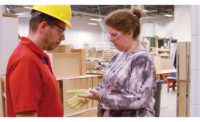
With literally thousands of choices available today in glove materials, glove styles and gloves designed for specific applications, how can safety pros select the proper hand protection for their workers? The plethora of possibilities makes this a choice that is more difficult than ever before.
Choosing the right glove for the job is a process that involves considering all of the possible hazards, reviewing current practices and worker compliance, reviewing past injury history and determining recent process changes. All of these factors come into play when making glove recommendations.
Gather the data
The first steps in glove selection involve reviewing the workplace, worker injury history and gloves currently being used in the workplace.What types of injuries? A useful tool in selecting hand protection is performing a hand protection survey. This audit should start with a review of hand injuries and near misses at each work area. Looking closely at what types of injuries have taken place at a given work site and the severity of the injury will determine the level of protection needed.
- Has there been lost work time resulting from cuts or lacerations?
- Would cut- and abrasion-resistant products have prevented the injury?
- Have there been either thermal or chemical burns?
- Would added insulation or heat-reflective materials have stopped the injury?
- What about liquid-proof/chemical-resistant products?
What are the hazards?,/b> Review and make note of all hazards that can be identified, including cut/abrasion potential, chemical exposure, and heat and cold injury potential. Special attention to areas that have potential risk needs to be noted. These areas would include “near-miss†locations that have been reviewed for past close calls. Applying the above questions to these areas will reveal additional potential hazards that need to be addressed in choosing the correct hand protection.
The right gloves? Finally, review the current glove products being used with an eye towards suitability of materials for protection against the noted hazards, service length, and worker compliance to help determine if a change in the hand protection program is needed. Is a cut-resistant material being used around cut hazards? Is there a chemical present that leads to exposure to skin hazards? Is there a heat or cold hazard present?
By systematically reviewing the job site, many hazards to hands can be identified. While this may seem like common sense, this type of review will emphasize hazards to which your workers are exposed daily.
Consider your options
Once the data is collected and noted, the review begins. Have a hand protection specialist review the data for suitability of the hand protection products currently being used (in some cases hand protection surveys are a service offered by glove manufacturers). A specialist can also introduce the features and benefits of the many new glove materials and designs that have been introduced in the past few years.A cut above — In the area of cut protection many advances in yarn materials have led to higher cut-resistant levels. “Engineering†yarns with aramid fibers (Kevlar®, Spectra, Dyneema®), steel strands and fiberglass are now allowing manufacturers to produce cut-resistant gloves that are many times stronger and yet lighter in weight than anything available in the past. Gloves made with these new materials result in increased worker compliance because they offer better dexterity and comfort while increasing protection levels.
A good grip — Many styles now available offer enhanced gripping potential, which naturally adds to worker safety. Polymer patterns such as dots and blocks and palm coatings add a gripping texture to the surface of knit or sewn fabric gloves. The materials in these grips are usually nitrile, polyurethane or natural rubber.
In recent years seamless knit gloves have been fully coated over the palm and fingers to add strength, support and service length to many glove designs. The flexibility and comfort of these products have resulted in increased protection and worker acceptance. The latest innovation is a form of “foamed†polymer (usually nitrile) that offers enhanced grip in oily conditions.
Beat the heat — Other glove materials offer thermal protection while also providing levels of cut resistance. The latest of these from Perfect Fit® Glove is Carbtex®, which is an aramid fiber blend that has some unique thermal blocking capabilities. This material resists heat transfer from flames, electric arc and other heat sources while offering cut and abrasion resistance.
New developments in yarn making and dipping technology are continually adding protective qualities to hand protection that were only dreamed of several years ago. The goal is added protection using more comfortable materials that workers will not resist wearing.
Rules of thumb
Finally, here are some additional tips regarding hand protection selection:
- Use the advice of hand protection specialists to introduce the latest technologies to your hand protection program.
- Encourage workers to practice glove use away from the job. An “at home injury†can still result in lost work time.
- Look for cost savings throughout the process in terms of injury reduction, service life and worker compliance. Cost savings are more than price savings on commodities.
- Workers will wear comfort and style. Safety can be fashionable, comfortable and effective with careful glove selection.
- Match hand protection to the job through a thorough glove survey.



